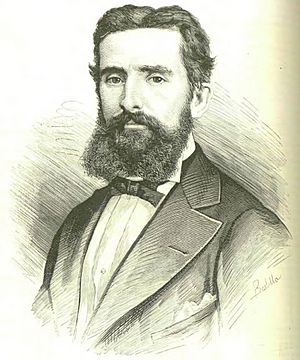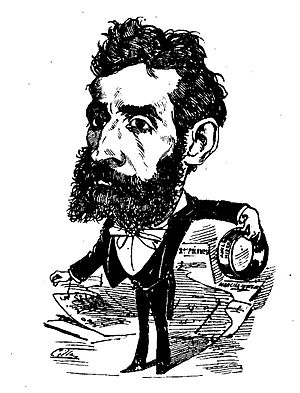Miguel Marqués (composer) facts for kids
Pedro Miguel Juan Buenaventura Bernadino Marqués y García (born May 20, 1843 – died February 26, 1918) was a talented Spanish composer and violinist. He wrote many pieces of music, including operas and symphonies.
Contents
Life of Miguel Marqués
Miguel Marqués was born in Palma, Majorca, Spain. His father made chocolate. From a very young age, Miguel showed a special gift for music. By the time he was eleven, he was already playing the violin for an opera company in Palma. He even wrote a special violin piece called Fantasía para violin that was very popular.
Between 1859 and 1863, his family helped him study music in Paris, France. From 1861, he studied violin at the Paris Conservatoire, a famous music school. In 1863, he joined the orchestra of the Théâtre Lyrique. He also started learning how to compose and arrange music with the famous composer Hector Berlioz.
Miguel Marqués returned to Majorca for his military service. But in 1866, he went back to studying music at the Madrid Royal Conservatory. He continued to study violin and composition. At the same time, he played in the orchestra of the Teatro de la Zarzuela. Later, he became an inspector for national music schools. He also taught singing to girls at a school in Madrid and wrote a book for violin teachers.
In 1894, he retired and moved back to his hometown of Palma. He also wrote some books about philosophy. Miguel Marqués passed away in Palma in 1918 when he was 74 years old.
He wrote five symphonies, but only his Third Symphony was printed while he was alive. All his symphonies were later put together by Ramón Sobrino between 1993 and 2003.
Musical Works
Miguel Marqués wrote many different kinds of music. Here are some of his most important works:
Stage Works
These are pieces written for the theater, like operas or plays.
- List of zarzuelas by Miguel Marqués (Zarzuelas are Spanish musical plays)
- El desengaño de un sueño (Incidental music for a play, 1876)
Choral Music
These pieces are written for a choir to sing.
- Mis plegarias íntimas (An oratory, which is a large musical work for voices and orchestra, 1911)
Symphonies and Orchestral Pieces
Symphonies are long musical works for a full orchestra.
- Symphony No. 1 in B flat major (1869)
- Symphony No. 2 in E flat major (1870)
- Symphony No. 3 in B minor, Op.30 (1876)
- Symphony No. 4 in E major (1878)
- Symphony No. 5 in C minor (1880)
- Una noche en la caleta (A night in the cove, 1871)
- La selva negra (The Black Forest, an overture, 1873)
- La cova del Drach (A symphonic poem about a cave in Majorca, 1904)
- La vida (Life, a symphonic poem, 1906)
- En la Alhambra (At the Alhambra, a small poem or suite)
- Oceánica (Oceanic, a symphonic poem)
Marches and Polonaises
These are pieces often used for parades or dances.
- Gran marcha de concierto No. 1 in C minor (Grand Concert March, 1871)
- Polonesa de concierto No. 1 in G major (Concert Polonaise, around 1872)
- Gran marcha nupcial (Grand Wedding March, 1878)
- Heroica, Marcha de concierto No. 4 (Heroic Concert March, 1882)
Concertos
A concerto is a piece for a solo instrument (like a violin) and an orchestra.
- Violin «Concerto» in E minor
Chamber Music
These pieces are for a small group of instruments.
- Fantasía for violin and piano
- Adagio in C major, for a quintet (five instruments)
Other Works
- La canción del marinero (The Sailor's Song, 1872)
- Ave Maria for voice and organ (1911)
- ¡Gloria a Mallorca! (Glory to Majorca!, 1915)
- Himne en honor de Ramon Llull (Hymn in honor of Ramon Llull, 1916)
- Te Deum for chorus and organ
- Capricho español (Spanish Caprice)
See also
 In Spanish: Miguel Marqués para niños
In Spanish: Miguel Marqués para niños




